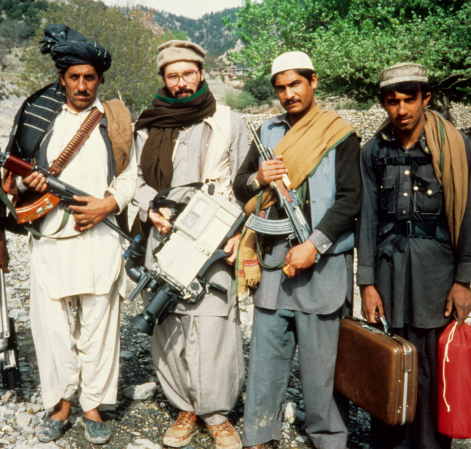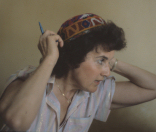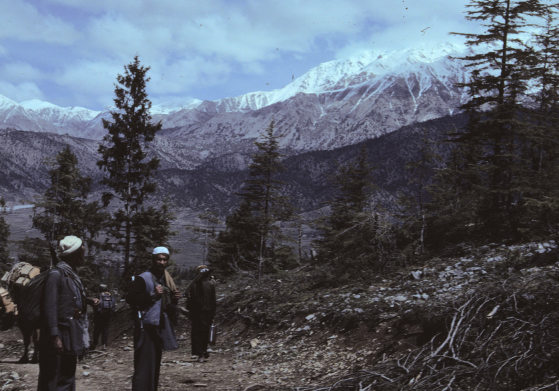SPIDER IN THE ROSE, LIZARD ON THE WALL
Covering the War in Afghanistan - 1984
by Richard Pauli
I AM SURE THAT I WAS THE FIRST, ALTHOUGH OTHERS WILL SURPASS MY DEEDS. There have been network crews smuggled deep into Afghanistan before and possibly may be there at this moment. But for a few days during the spring offensive I was a One-Man-Band with a high quality broadcast camera --40 miles from Kabul-- taking pictures of the war. (East of the Khyber Pass, West of Iran and between Russia and the Sea.)

On my back I carried a Sony BetaCam BVW-3 system, rechargable batteries and four hours of tape. My reporter and I walked for 20 miles. We toured recent battle sites, got pictures of Russian artillery shelling, and walked, prayed, ate, and bunked with the heavily armed Afghan Mujahadeen fighters. This war remains secret...remote and foreign, but with all the strategic importance intact. It is inconvenient for the press to cover. But the struggle is classical and clearly defined: A totalitarian superpower invader and a poorly equipped people organizing to defend their homeland.
We are beginning to see more of this war in which the Soviets are testing their weapons; MI-24 armored attack helicopters, the small butterfly mines, high altitude carpet bombing. The rest of the world should be seeing this too.
My opportunity was an assignment to be smuggled into Afghanistan; cover the war; remain highly mobile (and ready for a rapid exit) and bring back great pictures. In previous accounts by television correspondents I read horror stories of being separated from their film or video gear (by sometimes miles) at the very moment when helicopter gunships would attack...or of cameras loaded on mules on the other side of a river while a battle raged around them. In preparation for this trip I resolved never to be more than 30 seconds from rolling tape. This meant carrying with me always the 23lb BetaCam---a very high quality camera for such a trip. I was asking to do something that no sane broadcast organization would do (especially a local affiliate)-- send 50 thousand dollars worth of state-of-the-art ENG gear into a war zone. So my reporter and I sought a loan from Sony Corp. of their then state-of-the-art broadcasting gear. In planning this trip I was open to all photo suggestions -- half-inch video was the only solution. (OK follow this: CP-16-- simple & rugged but film cost high and weighs 1.5 lbs/400 ft. Half inch home VHS or Beta portables with lesser picture quality seemed possible...but the BetaCam is light, rugged, power conservative and best of all puts out great pictures.)

My reporter, Hilda Bryant, had been into Afghanistan before as a newspaper reporter. Her incredible contacts made all this possible. Bryant told me that we were to be smuggled in a car if lucky, or maybe do lots of walking thru mine fields if we weren't lucky. We had to travel light.
Getting into Afghanistan involved lots of waiting, phone calls, meetings and finally a late nite message delivered to us in Peshawar, Pakistan that we were to be ready at 5 A.M.-- dressed in native clothing, with a minimum of baggage. That morning we climbed into a jeep for the 5 hour drive through the tribal areas of the North West Frontier Provinces of Pakistan. This is a zone of Asia without government control...the roads to Afghanistan which allowed the travel of Mujahadeen fighters to and fro contained 8 check-points staffed during the day by Pakistan Government for the purpose of keeping out foreigners (for they cannot guarantee their safety). By night the roads are closed due to bandits. This is the nomadic area of Asia -- the ancient Kuchi camel caravans now mix with the Afghan refugees-- in the last few years over 4 million have fled eastward into Pakistan. Their tents and mud huts dwellings filled the roadside areas near water. For the beginning of our travels, our road was busy with colorful and gaudily painted trucks and busses loaded with men headed to their homeland to fight. Every male seemed to be well armed. AK-47s with one or two bandoliers seemed to be the standard. (The young males aspire to own an automatic like kids here own a car. Similar prices too... 1 or 2 thousand dollars or you capture one.)
In Parachinar, we stopped briefly at a high-walled compound owned by our hosts, one of the seven branches of the armies of Islamic Alliance. Lunch of meat and rice, we all sat on the floor, ate food with our right fingers and gave praise to Allah after a delicious fill. From there we drove past a few more check points in which I had to pretend to be asleep (for I could not speak pashto -- language of the Pathans). We hid the camera between my legs covered with a thin blanket. My reporter, Hilda was in an ambulance following us closely, so that if we were stopped for closer inspection they would honk to hurry the guards to let us pass. She was less concerned if stopped for she was veiled and in the Islamic world men do not speak directly to a woman - except for within their own families. After a ride on marginal roads -- some washed out, some barely wider than our vehicles -- we arrived at the tiny mountain garrison village of Teri Mangal. This was a muddy and bustling boom-town filled with stone and wood houses under construction and Mujahadeen soldiers loading supplies for the fighting near-by.
[Teri Mangal was carpet bombed in 1985]
Further thoughts – 2004
It seems that Teri Mangal was about 4 miles from the Tora Bora
Caves – we didn’t know that at the time… that is what a 2003 NYTimes map seemed
to show. This explains much of what happened to us. i.e. We were asked to stay inside, not to explore the area. We noted 50 cal guns used for target
practice. And lots of garrison activity.
And the Soviets considered this a target worthy of carpet bombing.
The border to Afghanistan is nearby and defined by another check-point, but other than a map-formality, the border seemed to be ignored by all who live on either side. However, as western journalists we had to avoid the last Pakistani Gov't post. So we walked over the low adjoining mountain pass. But in the foothills of the Hindu Kush range this low pass was a constant hike of 5 hours. We hiked up through high areas of timber harvesting operations -- hand hewn logs loaded on camels -- up to a ridge onto a smuggling road for our first glimpse of the Jajit province of Afghanistan -- 40 kilometers south of Kabul -- a key supply line area for the Mujahadeen. This is a beautiful land; clear, blue sky framed by tall snow capped mountains. I saw a lush green valley fed by glacier melt streams. We descended into the once busy town of Ali Khel, past the rusting carcass of Russian tanks.

On this warm spring day, my guides seemed to enjoy the trek, but they would constantly scan the skies and listen for the dreaded MI-24s attack helicopters feared by the Afghans. If we saw one we would take cover in the scrub brush of the hill side and cover ourselves with the earth-tone wool blanket that every Mujahadeen seemed to carry. The MI-24s are massive weapons platforms -- flying tanks. We were told that with great daring and good aim, small arms fire can bring one down. With Allah's blessing a well placed shot to the rotor system or the pilot's vent window will do it.
The altitude in which we hiked, the thrill of new and previously unseen sights gave me new energy. I shot lots of tape of ruins, 5 more tank bodies, mines dropped by air, shell casings littering the fields and lots of walking. Once, I hiked off the road and my hosts shouted to me to stop. I was chilled by the warning that I had wandered onto a mine field. As I digested that fear I looked down to see that also I was among the shallow graves with the shrouded bones of the Russian dead. This was a battlefield the year before. The Russians had not or could not retrieve their dead. After careful extrication, I confined my camera angles to the well beaten path.
This area was formerly lush. In times of peace all of the fields are totally utilized -- but the terraced fields, small irrigation ditches are all destroyed by battles. The fields are rendered useless by the insidious butterfly mines designed only to maim. Because a foot-wounded soldier requires one or two others to help carry them to medical attention many days walk away, one small mine can remove 2 or 3 Mujahadeen fighters. An effective weapon for a footsoldier war. What the Russians failed to know was what I saw in the Peshawar hospitals: crippled and maimed soldiers eager to walk and fight again. This struggle seems to unify the Afghan people. It is what they call the "holy war".
Time and time again we were asked why the United States would not provide (more) heat-seeking missiles to help the cause. This latest conversation was broken by a loud boom of intermittent shelling in the valley below. A few hours walk to the targeted village to help with any wounded -- relieved to hear there were none. The shells landed on a mosque and some other buildings. The village tractor shared by many took a direct hit. The tractor had given my video batteries a jump charge the day before. This shelling was just a warning from the garrison 12 miles away.
Our hosts were preparing to attack the garrison soon. Now without power for the video camera, we could only return. As we traveled back to Pakistan we passed the heavily loaded mules loaded with cargo of mortar and machine guns, and food and medical supplies. I was invited to witness the attack. Thinking that the still camera pictures might not be worth the 10 hour walk and a risk of death, I graciously declined the invitation. We later heard that the garrison held, though it sustained heavy damage and was left burning under a heavy storm.
This is a real war. It is for the most part unseen for it is on a part of the planet little see by the western press.
With our planet being wired and linked by satellite like a giant organism, the myth of history should belong to everyone. Photojournalists are the mobile witnesses to our civilization. The new tools are making them faster, lighter and more connected than ever before.
2004 Comment: – Amazing
what has not transpired in the world.
Technology can be in almost anyone’s hands and visual and journalistic
reach is now deeper than ever. But the
passive censorship of our mass media is stronger than ever. We were independent because we came from a
small organization – and our reports were to very limited audiences. Now only heavily funded organizations can do
this. And the journalism is too brief
and images too selective. The
technology is not really shrinking the planet, just extending the domain of
large content delivery entities. The
Internet counteracts much of that – but the audience is not the same. RP
2004
(If anyone travels to that area, I hope they can share images and thoughts)
2005 Comments 21 years later
2008 notes: ========= For the
TV documentary "Scenes from a Secret War"
broadcast on KIRO-TV in May 1984, Richard Pauli shared an Emmy Award with Hilda Bryant for
Investigative Journalism. This 30 min show aired in 1984 along with brief reports on the opium trade in the area. Copyrights 1998 and 2004 Richard Pauli
Great maps available on the Internet Map of the area around Teri Mangal
Time Magazine article June 1987
The Second Afghan War, 1878-80: Official Account 1908 Teri Mangal - MacGregor